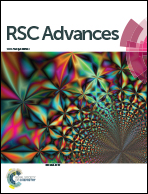Explanation for the selective crystallization from inosine solutions using mid-frequency Raman difference spectra analysis†
Abstract
Mid-frequency Raman difference spectra (MFRDS) analysis can be used to reveal the selective crystallization from solutions through determining the degree of similarity of the short-range orders between the assemblies of small organic molecules in solutions and their solid phases. Four solid phases of inosine (IR) (α-anhydrous IR (α-IR), β-anhydrous IR (β-IR), IR dihydrate (IRD), and amorphous IR (AmIR)) and two IR solutions (aqueous and 70 vol% DMSO aqueous solution) were prepared and characterized using MFRDS here. The MFRDS analysis results indicate that the selective formation of IRD and AmIR from IR aqueous solution and β-IR from IR 70 vol% DMSO solution are originated from the high similarity of their short-range structures. Moreover, we propose that the formation of α-IR from IR aqueous solution benefits from the appearance of AmIR as an intermediate phase. MFRDS is a robust tool to explain and predict the possible precipitation products from various solutions of small organic molecules.



 Please wait while we load your content...
Please wait while we load your content...